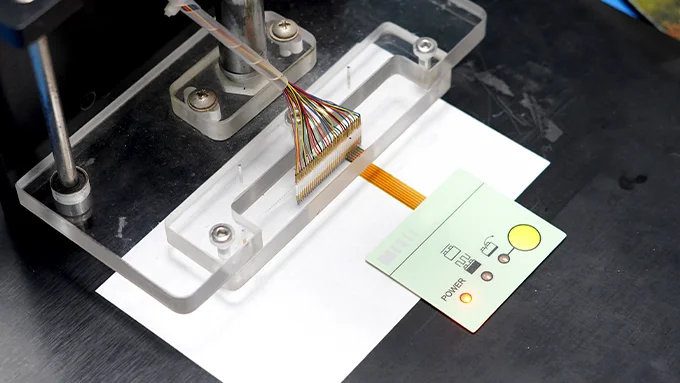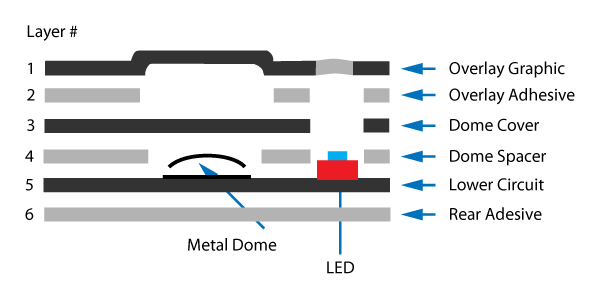How to choose the right membrane switch for any sector
Comprehending the Value of Membrane Layer Switch Over in Modern Electronic Devices
Membrane buttons are important parts in contemporary electronic devices. They supply a blend of functionality and style that enhances user interaction. Their resilient and lightweight nature makes them ideal for numerous applications. As industries progress, the demand for modification and advanced functions expands. Understanding how membrane switches add to technology discloses their significance fit the future of electronics. What exists in advance for this modern technology?
The Fundamentals of Membrane Switch Innovation
Although often overlooked, membrane button technology plays an important role in the modern-day electronic devices landscape - membrane switch. These gadgets, made up of numerous layers, work as customer interfaces for various electronic items, ranging from house appliances to medical devices. A common membrane switch contains a graphic overlay, a spacer layer, and a circuit layer, which are diligently constructed to produce a functional interface.When pressure is used to the overlay, the circuit layer is completed, permitting signals to be transferred to the gadget. This innovation is known for its flexibility, making it possible for personalization in shape, functionality, and style to meet details customer demands. Furthermore, membrane layer switches are slim and lightweight, making them suitable for applications where area is a costs. Their toughness and resistance to ecological factors further boost their charm, ensuring they can hold up against harsh problems while preserving performance. Generally, membrane layer switch modern technology is integral to developing reliable and easy to use digital gadgets

Key Benefits of Membrane Switches
Membrane layer changes deal a number of vital advantages that make them a preferred option in various digital applications. Their design enables a portable type element, allowing suppliers to create light-weight and streamlined devices. Additionally, membrane buttons are immune to dirt, moisture, and chemicals, which improves their sturdiness and longevity in requiring atmospheres. The tactile feedback provided by these buttons can boost customer experience, making them very easy and instinctive to operate.Furthermore, membrane buttons can be personalized with diverse graphics and shades, permitting special branding possibilities. The manufacturing process is typically economical, especially for high-volume manufacturing, as it lowers assembly time and streamlines design. Finally, membrane switches over require marginal maintenance, adding to lower general operational prices. These benefits emphasize their expanding popularity in modern-day electronic devices, where integrity and straightforward interfaces are crucial.

Applications Throughout Various Industries
The convenience of membrane switches over enables their widespread fostering across different sectors. In the clinical area, they are typically used in analysis equipment and person monitoring systems, supplying a resilient interface resistant to impurities. The automobile industry utilizes membrane switches for control panel controls, improving user experience with streamlined designs that endure harsh problems. In consumer electronics, they act as control panels for gadgets such as microwaves and coffee manufacturers, giving an user-friendly user interface that is simple to clean. The aerospace field uses membrane layer switches in cockpit controls, where reliability and room effectiveness are critical. In addition, the industrial sector leverages these buttons in machinery and control systems to ensure robust procedure sought after settings. This broad variety of applications highlights the versatility of membrane buttons, making them essential components in boosting functionality and customer interaction across varied technological landscapes.
Personalization and Layout Adaptability

Future Fads in Membrane Layer Switch Development
Emerging patterns in membrane layer button advancement indicate an expanding emphasis on improved capability and integration with clever modern technologies. As consumer need for extra innovative digital devices boosts, manufacturers are concentrating on developing membrane switches that not only offer fundamental operational functions but likewise integrate attributes like touch level of sensitivity, backlighting, and haptic feedback.Furthermore, innovations in products are anticipated to boost toughness and environmental resistance, making membrane layer switches over ideal for varied applications in markets such as health care, auto, and customer electronic devices. The assimilation of capacitive touch modern technology is likely to end up being extra common, permitting sleeker designs and boosted customer interfaces. membrane switch.Additionally, the rise of the Net of Things (IoT) is prompting the advancement of membrane changes that can interact wirelessly with other tools, enhancing interconnectivity. In general, the future of membrane switch technology shows up encouraging, driven by innovation and the quest of easy to use services
Often Asked Concerns
How Do Membrane Changes Compare to Traditional Mechanical Buttons?
Membrane buttons, being a lot more space-efficient and offering a streamlined style, contrast with typical mechanical switches that give responsive comments. The former typically include customizable graphics, while the last normally assure resilience and dependability in numerous applications.
What Materials Are Generally Utilized in Membrane Switch Manufacturing?
Membrane switches are generally generated making use of materials such as polyester, polycarbonate, and published conductive inks. These materials give responsiveness, sturdiness, and flexibility, making them suitable for different applications in digital devices and interface.
Can Membrane Layer Switches Be Repaired or Reused?
Membrane layer switches can often be fixed, especially if small concerns develop, such as glue failing or surface damages. Complete reuse is commonly limited due to put on and prospective destruction of materials over time.
How Do Ecological Aspects Affect Membrane Layer Change Efficiency?
Environmental aspects, such as temperature level, direct exposure, and moisture to chemicals, significantly affect membrane button efficiency. Severe problems can result in deterioration, her comment is here influencing responsiveness and longevity, inevitably jeopardizing the functionality of the device in different applications.
What Is the Typical Life Expectancy of a Membrane Change?
The regular lifespan of a membrane layer button usually varies from 1 to 5 million actuations, depending on factors such as use regularity, ecological conditions, and the products utilized in manufacturing, impacting longevity and performance long life. A common membrane button is composed of a graphic overlay, a click this link spacer layer, and a circuit layer, which are meticulously set up to create a practical interface - membrane switch.When pressure is applied to the overlay, the circuit layer is finished, allowing signals to be sent to the tool. The responsive feedback given by these switches can boost user experience, making them user-friendly and very easy to operate.Furthermore, membrane buttons can be customized with diverse graphics and colors, permitting for special branding chances. As consumer need for a lot more innovative electronic gadgets increases, producers are focusing on developing membrane switches that not just serve standard operational roles yet also include features like touch level of sensitivity, backlighting, and haptic feedback.Furthermore, innovations in materials are anticipated to boost sturdiness and environmental resistance, making membrane layer switches suitable for varied applications in sectors such as healthcare, vehicle, and customer electronics. The combination of capacitive touch innovation is most likely to end up being more prevalent, permitting for sleeker styles and boosted customer interfaces.Additionally, the surge of the Internet of Points (IoT) is prompting the advancement of membrane changes that can interact wirelessly with various other gadgets, improving interconnectivity. Membrane switches, being a lot more space-efficient and providing a streamlined style, comparison with typical mechanical switches that provide responsive comments